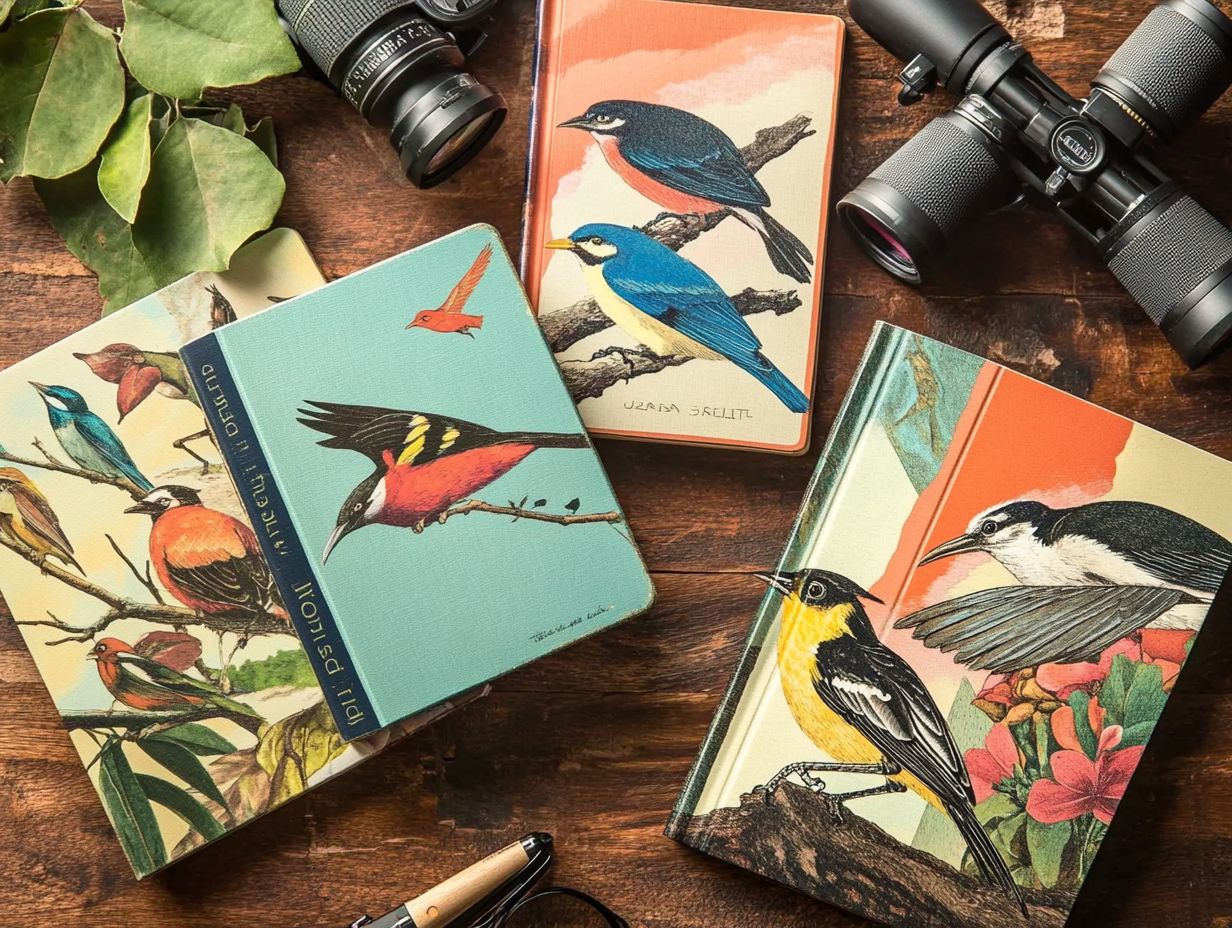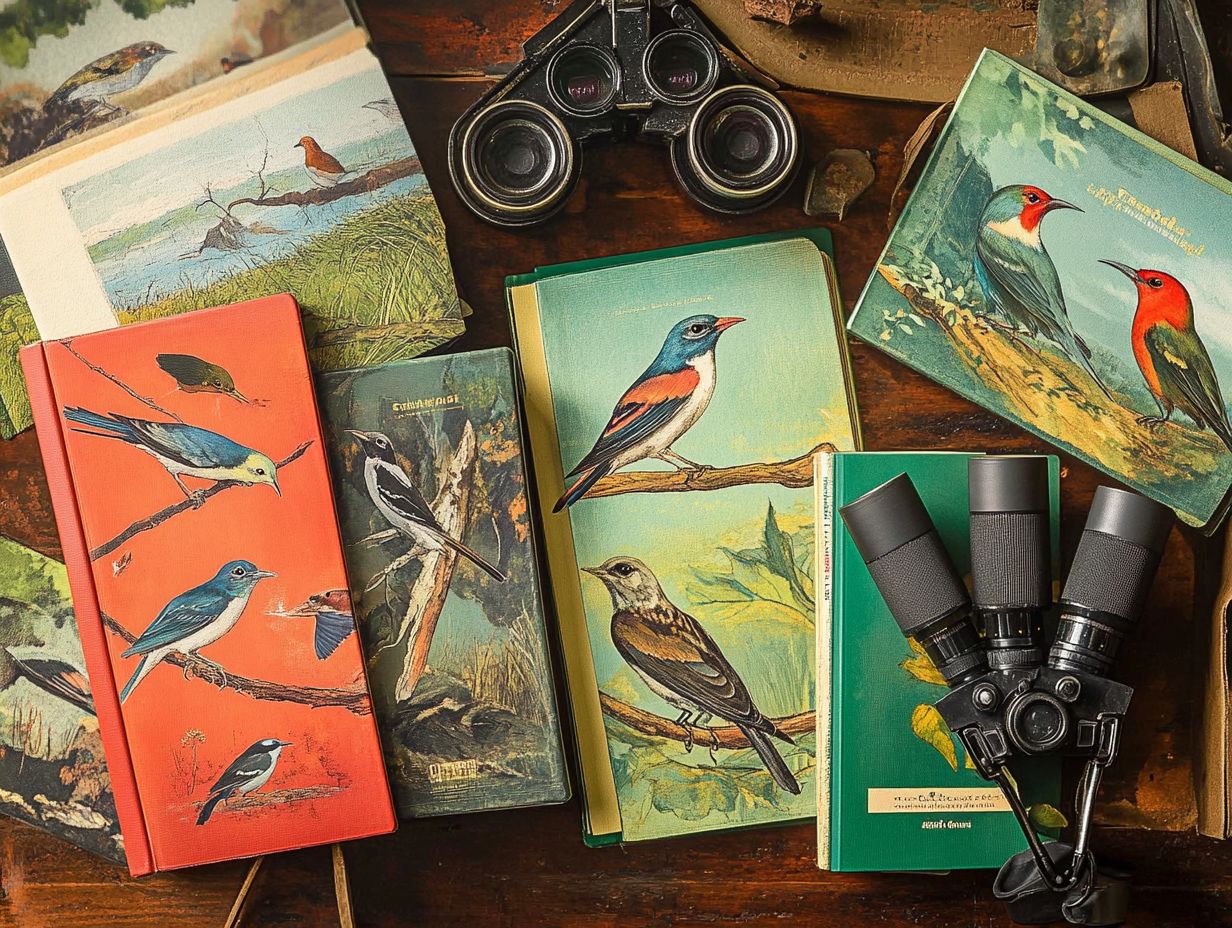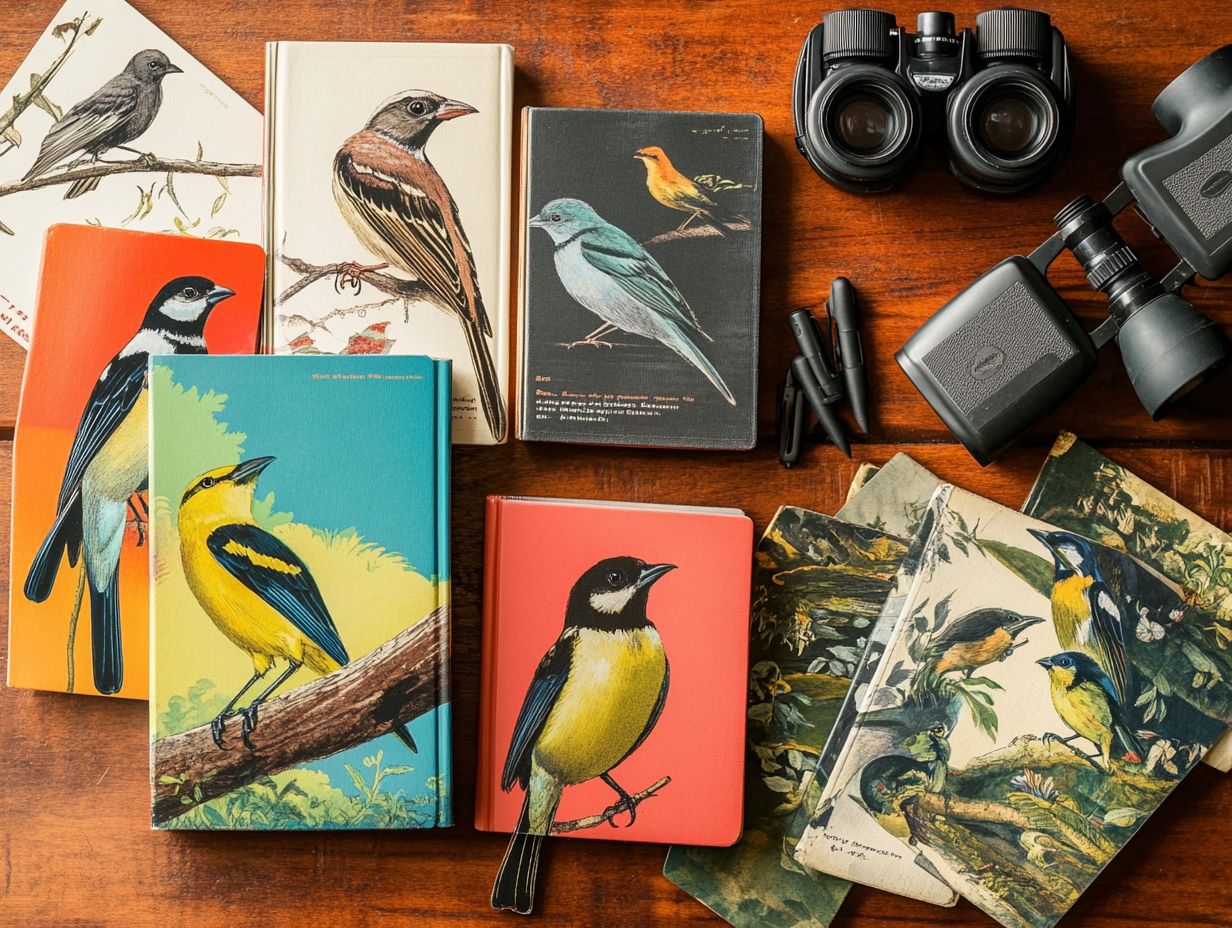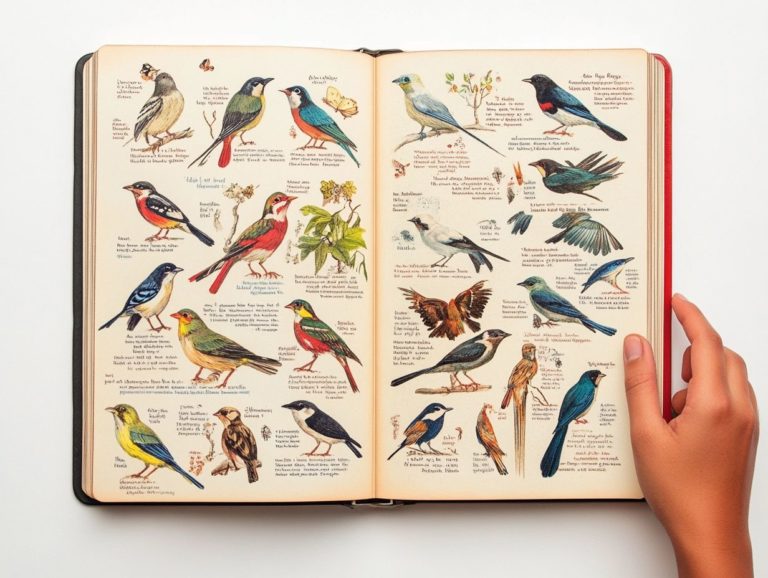The Most Useful Field Guides for Travel Birding
Birding offers an enchanting way to immerse yourself in nature. Possessing the right field guide can significantly elevate your experience.
As you explore the vibrant forests of North America or the diverse ecosystems of South America, you’ll encounter a myriad of unique avian wonders that each region has to offer.
Explore our handpicked selection of must-have field guides designed specifically for birding enthusiasts like you, no matter where in the world you find yourself.
From expert tips on selecting the ideal guide to valuable insights into bird distribution that can enhance your birding adventures, everything you require to embark on your next journey is right here.
Ready to find your perfect birding companion? Let s dive into the best guides!
Contents
- Key Takeaways:
- 1. The Best Field Guides for Birding in North America
- 2. Essential Field Guides for Birding in Europe
- 3. Must-Have Field Guides for Birding in South America
- 4. Top Field Guides for Birding in Africa
- 5. Comprehensive Guides for Birding in Asia
- 6. Handy Field Guides for Birding in Australia and Oceania
- 7. The Most Useful Field Guides for Birding in the Caribbean
- 8. Compact Guides for Birding in Central America
- 9. Detailed Guides for Birding in the Middle East
- 10. Unique Field Guides for Birding in Antarctica
- 11. How to Choose the Right Field Guide for Your Destination
- Frequently Asked Questions
- Which are the most popular field guides for travel birding?
- What makes these field guides the most useful for travel birding?
- Are there any field guides specifically designed for international travel birding?
- Can I find digital versions of these field guides and bird apps?
- Are there any field guides specifically for beginner birders, like the Sibley Guide to Birds?
- Are there any field guides for birders who prefer illustrations over photographs?
Key Takeaways:

- Choose a field guide specific to your destination for the best birding experience.
- Key features to look for in a field guide include detailed illustrations, range maps, and species information.
- A field guide can enhance your birding experience by helping you identify and learn about different species.
1. The Best Field Guides for Birding in North America
When it comes to bird identification in North America, having various field guides is crucial. This applies whether you re just starting or are a seasoned birdwatcher.
The Sibley Guide to Birds, Kaufman Field Guide, and Peterson Guide to Birds of North America stand out as some of the most respected resources in the field. For those seeking additional resources, the top field guides for coastal birding adventures offer unique insights that can elevate your birding experience.
Whether you prefer the tactile nature of printed guides for field use or the convenience of digital versions, these resources equip you with the tools necessary to enhance your birdwatching adventures.
These guides do more than just provide detailed bird illustrations and descriptions; they highlight key characteristics like size, plumage variations, and typical behaviors, essential for distinguishing similar species.
For instance, the Sibley Guide features a distinctive layout that enables quick comparisons. The Kaufman Field Guide takes a straightforward approach with stunning photographs that truly capture the essence of each bird. The Peterson Guide enhances your understanding by incorporating helpful range maps that show you where different birds can be spotted across the continent.
Each of these guides serves as a valuable companion, fostering a deeper connection with and appreciation for North America’s rich tapestry of birdlife.
2. Essential Field Guides for Birding in Europe
In Europe, bird identification is made effortless with a selection of essential field guides tailored to meet the diverse needs of birdwatching enthusiasts.
These guides hold particular importance for those venturing into the continent’s rich array of habitats, from lush wetlands and dense forests to majestic mountains and serene coastal areas.
For example, the Collins Bird Guide is celebrated for its stunning illustrations and detailed descriptions, making it an invaluable resource for identifying birds in diverse environments.
On the other hand, the Birds of Europe guide focuses on regionally unique species, offering insights into their vocalizations and behaviors. Specialized guides, including the National Geographic Field Guide, empower both novice and seasoned birdwatchers to deepen their appreciation for the unique avian life flourishing within Europe s varied ecosystems.
3. Must-Have Field Guides for Birding in South America
South America is truly a birdwatcher’s paradise. It is filled with an astonishing variety of species. This makes having the right field guides, such as the Golden Guide, essential for accurately identifying birds and understanding their distribution throughout the region.
With its rich tapestry of ecosystems, from the verdant Amazon rainforest to the stark beauty of the Atacama Desert, South America is home to over 3,500 bird species. Many of these species are unique to this continent. These guides bring birds to life, making every outing an adventure! They do more than simply list birds; they categorize them by their specific habitats and include exquisite illustrations and photographs to assist with visual recognition.
As you delve into these invaluable resources, including Merlin Bird ID and bird songs, you ll find features like seasonal migration patterns when birds move from one place to another throughout the year vocalizations, and expert tips for spotting those elusive species. These insights are vital for elevating your birding experience. Such tools empower both newcomers and seasoned enthusiasts to fully appreciate the unparalleled avian diversity that South America has to offer. Grab your field guide today and embark on an unforgettable birdwatching adventure in South America!
4. Top Field Guides for Birding in Africa
Birding in Africa presents a unique experience. Top-tier field guides assist you in navigating the continent s rich avian diversity and accurately identifying countless species.
These guides are invaluable for bird watchers like you. They offer detailed illustrations and informative descriptions that illuminate the habits and habitats of various birds. Picture vibrant parrots flitting through tropical rainforests or majestic raptors soaring gracefully over the savannah it s a mesmerizing tapestry of avian life.
By utilizing quality field guides, such as Birds of Central America, you can cultivate a deeper understanding of regional ecosystems and the essential roles different species play within them. Whether you re exploring lush wetlands or arid woodlands, these resources not only elevate your enjoyment of birdwatching but also deepen your appreciation for Africa’s ecological wonders.
5. Comprehensive Guides for Birding in Asia
Asia’s vast landscapes and rich biodiversity demand comprehensive guides for birding. These guides for understanding bird identification are essential for accurate identification and an enriching birdwatching experience.
These guides serve a crucial role in equipping you with knowledge about various species. They offer insights into their unique behaviors and habitat preferences across diverse ecosystems. For instance, the ‘Birds of Southeast Asia’ guide not only provides details for identifying endemic species but also explores their migratory patterns and nesting habits. This deepens your understanding of avian life in that region.
Similarly, guides focused on the Himalayas highlight the specific adaptations of birds that thrive in high-altitude environments. They emphasize the need for localized knowledge. With these invaluable resources at your disposal, you gain a profound appreciation for the intricate relationships between species and their habitats.
6. Handy Field Guides for Birding in Australia and Oceania

Australia and Oceania are home to a remarkable array of avian species. Field guides are vital for you as a birdwatcher striving for accurate identification in these diverse regions.
These guides offer stunning bird illustrations and essential insights into the habitats, behaviors, and calls of the birds you ll encounter. They ensure you appreciate their unique characteristics. Whether you’re navigating the lush rainforests of Papua New Guinea or the stark beauty of the Australian outback, having a reliable reference can elevate your experience tremendously.
Many field guides are compact and designed for convenience. This enables both beginners and seasoned birders to quickly identify their sightings while soaking in the breathtaking natural environment. With such a rich variety of birds, including the Birds of the West Indies, from the vibrant rainbow lorikeet to the elusive kiwi, these resources will deepen your appreciation for the avian wonders that call this part of the world home.
7. The Most Useful Field Guides for Birding in the Caribbean
In the Caribbean, the best field guides provide essential insights into the region’s extraordinary bird life, helping you understand bird behavior and elevating your bird identification experience to new heights.
These guides often feature stunning illustrations that vividly capture the vibrant colors and distinctive markings of local species. This makes it easy to recognize the birds in their natural habitats.
For example, comprehensive species accounts, like those in Birds of Trinidad & Tobago, offer details on behavior, vocalizations, and habitats. This enriches your understanding of bird behavior and habitats, whether you’re a novice or a seasoned birder.
While exploring the lush landscapes and tropical islands, you may face challenges, such as diverse ecosystems and distinguishing between similar species. However, with well-crafted field guides, including Birds of Patagonia, you can turn these challenges into thrilling adventures!
These resources offer rewarding opportunities for discovery and help build a deeper appreciation of the rich biodiversity in this captivating region.
8. Compact Guides for Birding in Central America
Compact guides for birding in Central America are invaluable tools for you as an enthusiast eager to explore and identify the remarkable bird species in this biodiverse region, especially those found in the top 10 bird guides available online.
Portable resources, like the Birds of Northern Central America, focus on the unique avian diversity across various habitats, such as rainforests, wetlands, or mountains. Their convenient size allows you to easily slip them into your backpack or pocket, ensuring essential information is always at your fingertips.
These guides provide details on the distribution patterns of each species, empowering you to engage more deeply with the local ecosystem. They enhance your birdwatching experience with insights into bird distribution across different environments.
Key guides like the Sibley Guide and the Peterson Guide to Birds of North America cover everything from common residents to rare migrants, painting a vivid picture of the avian life thriving in this vibrant region.
9. Detailed Guides for Birding in the Middle East
The Middle East boasts a captivating diversity of bird species, making detailed guides essential for accurate identification and appreciation of the region’s unique bird life.
Birding here isn’t without hurdles. You may face extreme weather conditions during birding tours and contend with diverse landscapes that host various bird species. Limited access to certain habitats highlights the need for digital guides like the Merlin Bird ID.
Local expertise is invaluable, especially since migratory patterns and the routes birds take during seasonal travels can change unexpectedly. Field guides provide key information about local birds and their preferred habitats, helping you navigate these challenges with confidence.
By exploring the intricate ecosystems crucial for bird distribution and conservation efforts, and understanding seasonal movements with guides like the Kaufman Field Guide, you can elevate your birding experience. Printed guides such as the Golden Guide and resources like the National Geographic Field Guides help you cultivate a profound connection with the breathtaking wildlife in the Middle East.
10. Unique Field Guides for Birding in Antarctica
Experience birding in Antarctica like never before! This unique destination requires specialized field guides to help identify the extraordinary birds that thrive in this extreme environment.
These guides not only assist you in navigating the icy terrains but also deepen your understanding of the remarkable adaptations that enable birds, such as the resilient emperor penguin, a fascinating species covered in the Peterson Guide and the nimble light-mantled sooty albatross, along with other avian wonders found in Antarctica, to endure in such unforgiving conditions. These guides detail the behaviors of birds from the Birds of Patagonia, migration patterns, and breeding habits, shedding light on the challenges these species face due to climate change impacts on birds in South America and habitat loss in the regions described in the Sibley Guide to Birds.
The breathtaking beauty of the Antarctic landscape documented in various photography guides further elevates your birdwatching adventure. It s exciting to have tools that capture the majesty and ecological significance of this remote region.
11. How to Choose the Right Field Guide for Your Destination
Choosing the right field guide for your birding destination is essential for effective bird identification and enhancing your overall birdwatching experience, particularly when considering the regional variations in species. Be sure to explore the top features to look for in a bird field guide to ensure you have the best resources at hand.
A well-crafted guide tailored to specific regions ensures that you encounter accurate information on bird song recognition, a crucial skill for birdwatchers, emphasized in many modern bird apps and calls. This allows you to forge a deeper connection to local ecosystems, as noted in the Birds of the West Indies. User-friendliness is key; guides featuring a clear layout, as seen in the All About Birds website, intuitive navigation in digital guides, and varying levels of detail cater to both beginners and seasoned birdwatchers alike.
The inclusion of vivid bird illustrations that aid in species identification, like those in the Peterson Guide to Birds of North America, alongside pertinent information, helps you in recognizing distinctive features of various birds, a highlight of the Cornell Lab’s resources.
By selecting a guide that aligns with your needs, you can elevate your identification skills while reveling in the joys of observing these magnificent creatures found in Birds of Brazil in their natural habitats.
What Are the Key Features to Look for in a Field Guide?

When choosing a field guide, prioritize user-friendliness in both printed and digital formats. Look for high-quality illustrations that aid in accurate species identification and comprehensive information, like that in the Sibley Guide.
A well-designed layout significantly enhances usability, making it easy for even novice birdwatchers to navigate with confidence. Effective organization often achieved through color coding systems used in guides like the Kaufman Field Guide or grouping species by habitat, particularly useful in regional guides allows you to quickly find the birds that spark your interest.
Look for detailed illustrations highlighting the subtleties of plumage differences among species that are essential for recognizing Birds of Colombia, size and coloration differences as shown in the Golden Guide, and distinguishing marks that are crucial for identifying birds through the lens of conservation efforts in the field. These carefully considered elements not only streamline your birdwatching adventures but also deepen your connection to the avian world, enriching every outing with knowledge and excitement.
How Can a Field Guide Enhance Your Birding Experience?
A field guide significantly elevates your birding experience by equipping you with essential information for identifying birds, deepening your appreciation for wildlife, and bolstering conservation efforts.
This invaluable resource not only aids in accurately recognizing various species but also offers insights into their behaviors and habitats. The guide highlights unique features and calls of birds, encouraging you to connect more with the bird world around you.
It serves as an important reminder of biodiversity, which is essential for wildlife conservation and the delicate balance of ecosystems. This inspires you to take part in and advocate for conservation initiatives supported by the Cornell Lab and other organizations. With a field guide, you can become a champion for wildlife preservation, a key aspect of birding tours, helping everyone commit to safeguarding our planet’s natural treasures that include various species across North America and Central America.
What Are the Benefits of Using a Digital Field Guide?
Digital field guides, such as bird apps that provide real-time updates on sightings available through Merlin Bird ID, provide you with a wealth of benefits for bird identification. They deliver convenience, accessibility, and up-to-date information for birdwatching wherever you go.
These modern tools are great because they provide real-time updates, ensuring you have the most current data on bird species and sightings at your fingertips. Interactive features like audio calls and vivid photographs that enhance the learning experience enriched by detailed guides like the National Geographic Field Guide elevate your experience, allowing you to engage more deeply with your surroundings.
Quickly searching for species makes it easier to identify birds. This enhances your efficiency in using bird apps, turning each outing into a richly rewarding learning experience.
How Can a Beginner Benefit from Using a Field Guide?
For those just starting out, a field guide serves as an essential companion, laying a strong foundation for bird identification and enhancing the overall birdwatching experience. It nurtures a genuine passion for avian species.
With meticulously detailed illustrations and thoughtful descriptions, these guides become invaluable tools in your quest to understand the rich diversity of local birds. You ll find that recognizing common species in varied habitats, such as those in the Birds of Trinidad & Tobago by both sight and sound transforms your outdoor adventures into captivating learning moments.
As you become more acquainted with various traits like coloration and behavior you not only refine your observational skills but also deepen your connection with the natural world around you. This exciting engagement sparks your curiosity about local ecosystems, cultivating a sense of environmental stewardship and nurturing a lasting appreciation for the beauty of birdlife.
Over time, this journey through the guides can ignite a sincere passion for ornithology, the study of birds, inviting you to explore even further into the wonders of nature.
What Are the Most Common Mistakes to Avoid When Using a Field Guide?
When you dive into using a field guide, it’s common to stumble over familiar mistakes like misidentifying species or missing key characteristics essential for accurate bird identification.
Don t let these common pitfalls frustrate your birding experience! They can lead to frustration and confusion, especially since many overlook regional variations that influence the appearance and behavior of birds. It’s easy to miss specific identifying features those subtle differences in plumage (the feathers of birds) or variations in song (the sounds birds make) that can significantly impact your identification accuracy.
To sharpen your skills, spend time learning about local birds and their habitats. Practice with visual aids to enhance your birding skills. Don t hesitate to join birdwatching groups that provide community support and shared knowledge. By gaining hands-on experience and learning from seasoned birders, you’ll enhance your observational techniques and build confidence in your identification abilities.
Frequently Asked Questions
Which are the most popular field guides for travel birding?

- “Sibley’s Birding Basics” by David Allen Sibley
- “The National Geographic Field Guide to the Birds of North America” by Jon L. Dunn and Jonathan Alderfer
- “The Stokes Field Guide to the Birds of North America” by Donald and Lillian Stokes
What makes these field guides the most useful for travel birding?
These field guides are great for travel birding because they are compact, lightweight, and contain essential information and illustrations of birds found in different regions. For those looking to enhance their experience, the top bird field guides for international travel often include range maps, bird behavior, and vocalizations, making it easier for birders to identify and learn about new species while traveling.
Are there any field guides specifically designed for international travel birding?
Yes, there are field guides specifically designed for international travel birding, such as “The Sibley Field Guide to Birds of Eastern North America” and “The Sibley Field Guide to Birds of Western North America.” For a comprehensive selection, check out the best field guides for birding, which cover a vast range of species found in North America, making them useful for birders traveling to different countries within the continent.
Can I find digital versions of these field guides and bird apps?
Yes, many of these field guides, including popular digital guides like “Merlin Bird ID,” are available in digital formats, such as e-books or apps. This makes them even more convenient for travel birding as they can be easily accessed on a smartphone or tablet while on the go.
Are there any field guides specifically for beginner birders, like the Sibley Guide to Birds?
Yes, “Sibley’s Birding Basics” and the “Sibley Guide to Birds” are excellent resources for beginner birders. They provide a comprehensive introduction to birding techniques and bird identification, including information on bird anatomy, behavior, and habitats, making them fantastic resources for learning the basics of birding while traveling.
Are there any field guides for birders who prefer illustrations over photographs?
Yes, both “The National Geographic Field Guide to the Birds of North America,” the “Kaufman Field Guide,” and the “Peterson Guide” are renowned for their detailed illustrations. Some birders prefer these over photographs as they highlight key identification features and help distinguish between similar species. Resources like All About Birds offer valuable insights into bird distribution and conservation efforts.






